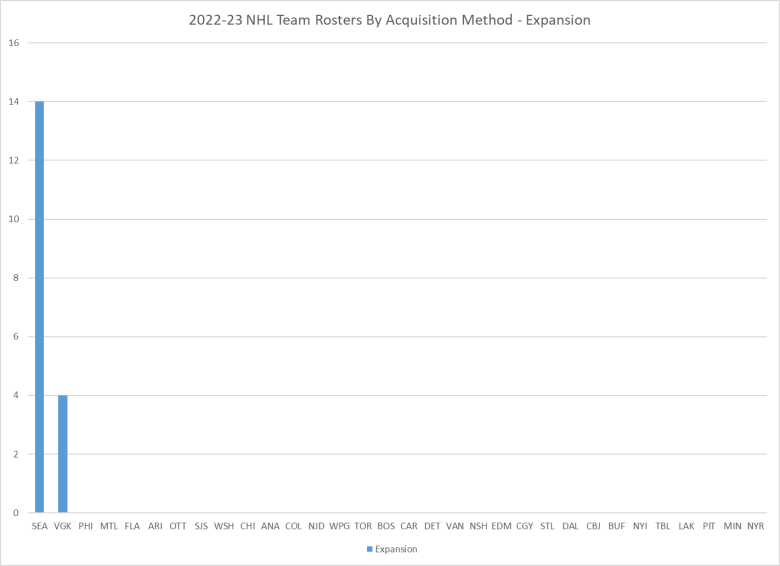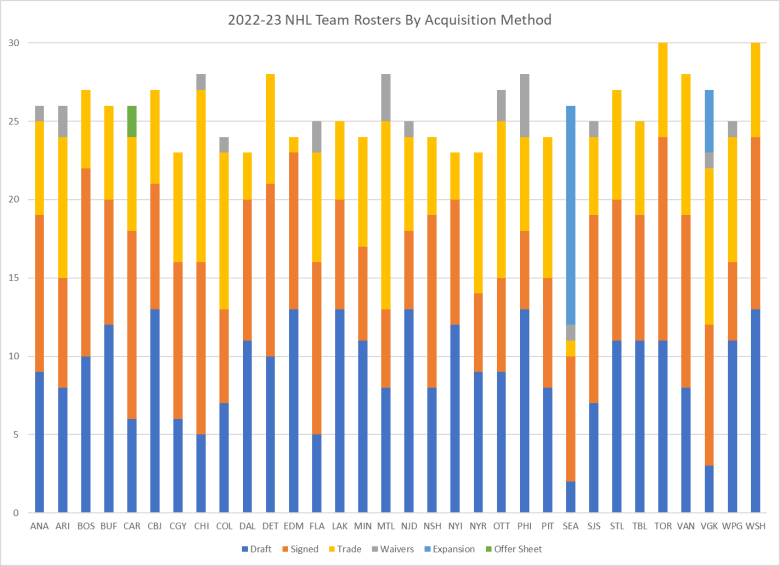The 2022–23 NHL season is well underway. From the frantic offseason featuring the NHL’s first ever sign-and-trade, to a massive extension that reset the bar on the highest AAV on a contract, the year has already seen its fair share of entertainment.
For the past few years, we have taken a look at each NHL roster and broken it down by acquisition method. To build an NHL roster, general managers have a few different options to acquire players: the draft, trades, signings, waivers, expansion, and offer sheets.
Of course, some teams have access to certain types of acquisition methods that others don’t, specifically the expansion draft that will only feature on the Vegas Golden Knights and the Seattle Kraken.
Let’s see how rosters shape up for 2022–23.
Roster players acquired via the draft
One of the hallmarks of good teams is their ability to grow talent from within, develop their drafted prospects into impact NHLers, and maximize the value of entry-level contracts. When it comes to drafted players, the general trend is to see very good teams that have been very good for a long time, like the Tampa Bay Lightning, and teams that are up-and-coming, like the New Jersey Devils, to have some of the most drafted players on their teams.
With star players opting to stick with their original team much more often nowadays than in the past, it is crucial to draft well and constantly have players pushing for NHL jobs. Just this season alone we saw big extensions given out to Jason Robertson, Mathew Barzal, Nathan MacKinnon, Jordan Kyrou, Tim Stutzle, Tage Thompson, and Josh Norris. Teams are learning that they need to back up the Brinks truck to keep their stars, and they’re doing it. It is nearly impossible to find these types of players in free agency so it is essential to draft top players and retain them for as long as possible.
For all the graphs in this article, information was gathered via CapFriendly. Not all teams run a standard 23-man roster; many teams utilize the long term injured reserve (LTIR) and season opening injured reserve (SOIR) to exceed both the roster limit and the salary cap.

The Washington Capitals are the league leading team for roster players drafted by the organization. Following the Capitals are the Edmonton Oilers, Philadelphia Flyers, and New Jersey Devils, Columbus Blue Jackets, and Los Angeles Kings. It’s a combination of teams that will threaten for the Cup this season, and teams that are up-and-coming with lots of young, drafted talent.
The Seattle Kraken and Vegas Golden Knights have the fewest drafted roster players but of course, this is due to them being recent expansion teams and simply not having enough drafts to accumulate and develop players. The Chicago Blackhawks and Florida Panthers have the fewest drafted players out of the non-expansion teams. They may have punted on this season, but for years, the Hawks have tried to kick the can down the road and provide their franchise players with the chance to win the Cup once again. Mortgaging the future will lead to that type of spot on this chart.
An interesting group of teams near the bottom are the Colorado Avalanche, Calgary Flames, and Carolina Hurricanes. While most of the Avalanche’s and Hurricanes’ stars are home grown drafted players, the rest of their roster is filled up by signed and traded players. The Flames lost three of their longest-tenured players this offseason in Johnny Gaudreau, Matthew Tkachuk, and Sean Monahan, opting to replace them with traded and signed players in Jonathan Huberdeau and Nazem Kadri.
Out of 829 roster players at this point this season, 296 were acquired by their teams via the draft. That represents 36% of all players and the most frequent acquisition method.
Roster players acquired via trade
Trading has become much more complicated than in the past. With all the different types of conditions that teams add to trades, whether it’s team performance or player performance, trade conditions have gotten incredibly specific and complex.
As we alluded to earlier, this offseason featured the NHL’s first ever sign-and-trade when the Flames traded Tkachuk to the Panthers.

The Montreal Canadiens and Chicago Blackhawks are the leaders in roster players acquired via trade. With 12 and 11 players on their roster acquired through trades with other teams respectively, this represents about 50% of a 23-man NHL roster. The Ottawa Senators, Avalanche, and Golden Knights are next with 10 traded players.
The Kraken and Oilers have just one player on their roster acquired via trade, Oliver Bjorkstrand (Seattle) and Klim Kostin (Edmonton).
Out of 829 roster players this season, 215 were acquired by their teams via trade. That represents 26% of all players and the third most frequent acquisition method.
Roster players acquired via signing
Free agency is always a busy time of the year. It used to be the time when players would finally get to cash in by testing the market, but the flat cap has made this difficult for top free agents. This is another reason why teams have been able to lock up their stars because they are able to offer cost certainty to their players a year in advance.
This type of acquisition method includes players signed in free agency. This exclusively includes unrestricted free agents, including those signed from other leagues and undrafted players. Restricted free agents who sign offer sheets are part of that acquisition method.

The Toronto Maple Leafs lead the league with 13 players acquired via free agent signing. The Bruins, Sharks, and Hurricanes are next at 12 players, and then it’s a steady staircase all the way down.
Five teams are tied for the fewest players acquired via signing with five: The Canadiens, New York Rangers, Winnipeg Jets, Devils, and Flyers.
Out of 829 roster players on opening night this season, 276 were acquired by their teams via signing. That represents 33% of all players and the second most frequent acquisition method.
Roster players acquired via waivers
Waivers are a very interesting part of the NHL’s CBA. At the beginning of the season, and especially the beginning of last season, there were a plethora of quality players available through waivers. However, almost none were claimed by other teams.
This season, however, we’re seeing an uptick in the total number of players added to rosters via waivers. It looks like teams are starting to take more chances on players put on the waiver wire. Don’t forget, 2021’s Calder Trophy finalist Alex Nedeljkovic was on waivers at the start of the season and wasn’t claimed. Maybe teams are starting to learn that it might make sense to take a flyer on a talented waiver wire pickup.

A total of 18 teams do not have any roster players that were acquired via waivers. Nine teams have one player added via waivers, three teams have two players, the Canadiens have three, and the league leader is the Flyers with four: Kieffer Bellows, Zack MacEwen, Lukas Sedlak, and Patrick Brown.
Out of 829 roster players on opening night this season, 22 were acquired by their teams via waivers. That represents 3% of all players and the most infrequent acquisition method other than offer sheets. This is an increase from last year where just 16 players were acquired via waivers.
Players acquired via expansion
This is a unique acquisition method that will eventually be irrelevant, but due to the Seattle expansion just occurring there are a decent number of players who qualify under this acquisition method.

Of course, there are only two teams that show up on this chart, Seattle and Vegas. It’s surprising to see Vegas with such a low number of players acquired via expansion. The Vegas expansion draft was in 2017, just five years ago. There has been significant turnover in Vegas’ roster over the past four years, and they’ve managed to remain a top Cup contender in each of those seasons, save for a tough end to the 2021–22 season. The only players that are still members of the Golden Knights from that were taken in the expansion draft are William Karlsson, Jonathan Marchessault, William Carrier, and Brayden McNabb.
Seattle has 14 players acquired via expansion. That’s down from 21 to start last season.
Out of 829 roster players on opening night this season, 18 were acquired by their teams via expansion. That represents 2% of all players and the second most infrequent acquisition method not including offer sheets.
Roster players acquired via offer sheets
This acquisition method is only included because of the Hurricanes. Last year, I broke down how rare offer sheets are in the NHL in the summer, and despite the juicy options for offer sheets this offseason, none were signed.

It’s a very boring graph, but the Hurricanes lead the league with two players acquired via offer sheets. No other team has any players who fall under this acquisition method.
Sebastian Aho actually signed an offer sheet with the Canadiens, but the Hurricanes smartly matched the offer sheet. The other player is Jesperi Kotkaniemi who was signed to an offer sheet last offseason by the Hurricanes from the Canadiens. The Canadiens smartly chose not to match the offer sheet.
Full breakdown of NHL rosters by acquisition method
The full breakdown of all teams by all acquisition methods is below.

What are your thoughts? Let us know in the comments or on social media @wincolumnCGY!
Photo by Brett Holmes/Icon Sportswire

You must be logged in to post a comment.